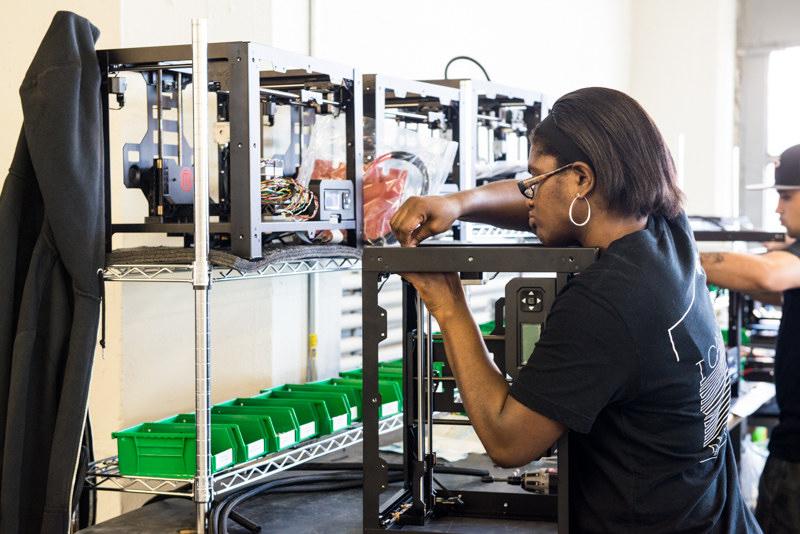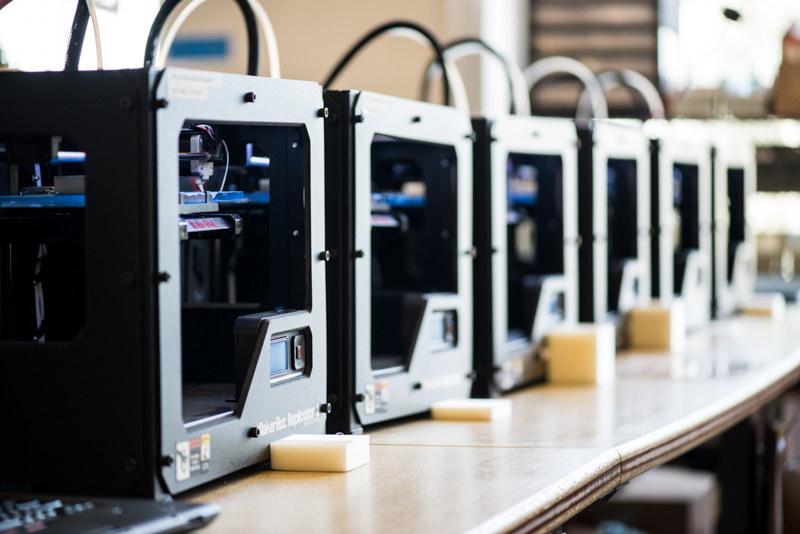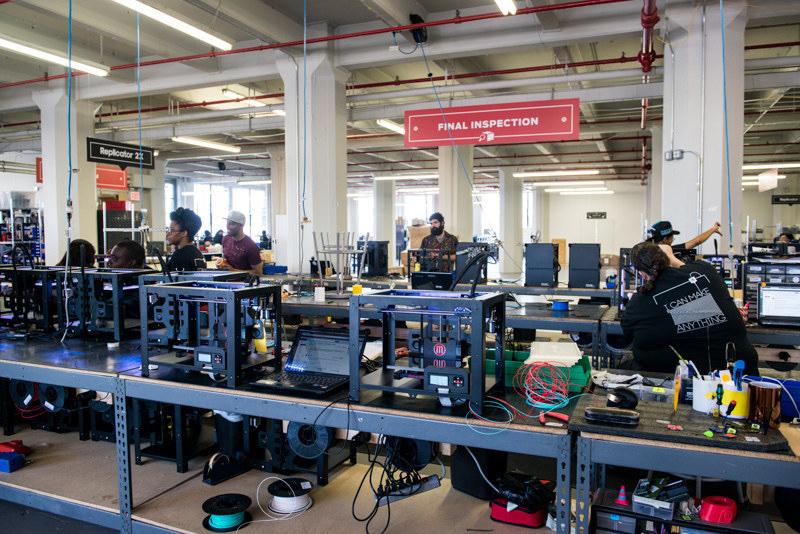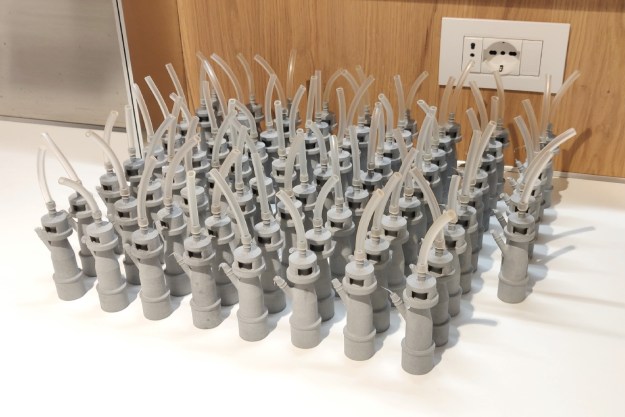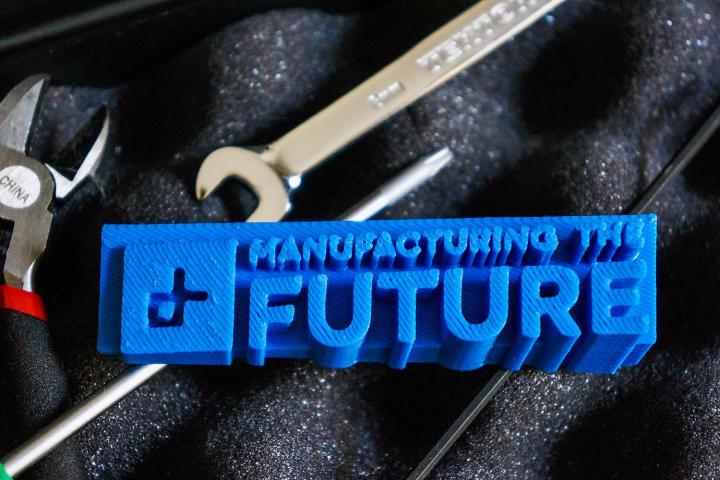
3D printers are all the rage with enthusiasts, but they didn’t just materialize out of nowhere like the sculptures they produce. Here’s the untold story of how the next big boom in technology came to be over 30 years.
It’s not a particularly well-produced video. There are no titles, no credits — no contextual information at all, really. The image is shaky, the sound full of static. The whole thing could have been shot on a phone.
A man stands alone in the desert in a black polo shirt and blue jeans, poorly framed in the video which crops off the top of his head. He adjusts a tethered earplug before turning his attention to the strangely shaped chunk of white plastic in his hands.
3D printing is here, and it’s about to change everything.
The man readies himself, shifting his weight and limbering up his arms. He raises the plastic mass eye level, its profile now registering clear similarities to a revolver. He squeezes off a shot with a bang. Orchestral music swells. He lowers the weapon and turns to the camera. Cut to stock footage of a bomber, then a sunset, and the words “DEFDIST PRESENTS LIBERATOR” overlaid across the screen.
There’s a lot to be desired here, so far as production quality is concerned, but its thesis is crystal clear: The 3D-printed gun had arrived – and with it came a remarkable transformation of … well, everything.
Four days after “Dawn of the Wiki Weapons” was uploaded, another video hit YouTube. Well-produced and unwaveringly emotional, it tells the story of Richard Van As, a South African master carpenter who built mechanical fingers to replace digits he’d lost in a work accident. Teaming with Washington-based special effects prop designer Ivan Owen and consumer 3D-printing powerhouse MakerBot, Van As launched Robohand, a non-profit aimed at outfitting young sufferers of Amniotic Band Syndrome with prosthetic appendages to help them lead fuller, richer lives.
A little over halfway through, the video’s true star speaks for the first time. “It’s fun to have,” young Liam says with a smile, manipulating the plastic prosthesis with ease. “I can do almost everything with it.”
As MakerBot happily reports, it’s the company’s low-cost, consumer-facing 3D printing that has made this dream possible. Prosthetics are expensive and quite impractical for children who will outgrow them almost as soon as they’ve been fitted for them. But what if the prosthesis grew with them? What 3D printing affords cash-strapped parents of children with disabilities is modular prostheses with parts that can be adjusted for size as the child grows — at a cost of about $5 for printed materials.
In the Netflix documentary Print the Legend – which began streaming online Friday — MakerBot Chief Strategy Office Jenny Lawton admits to accelerating release of the Robohand to offer a powerful counterpoint to the almost instantly viral Liberator video. “Once the gun video came out, we actually pushed that up a few days,” confesses Lawton. “That was our response to the gun thing.” To date, Robohand has racked up more than 500,000 views on YouTube — an impressive number to be sure, but a mere fraction of the gun’s 3.7 million.

The two videos differed wildly with regard to tone and production costs, but both speak to the same fundamental truth: The impact of 3D printing is only beginning to be understood by the world. Three months before their release, President Obama delivered his State of the Union to Congress. In a speech highlighting the role of technology in the future of American manufacturing, the leader of the free world name-checked the additive manufacturing happening in a Youngstown, Ohio plant. “A once-shuttered warehouse is now a state-of-the art lab where new workers are mastering the 3D printing that has the potential to revolutionize the way we make almost everything. There’s no reason this can’t happen in other towns.”
It’s difficult to imagine a more powerful endorsement of a technology than a State of the Union heralding the return of manufacturing to the depressed Rust Belt. But shortly after the premier of the Liberator video, New York Senator Chuck Schumer cited the availability of printable guns as part of his case for passing the Undetectable Firearms Modernization Act. A terrorist, someone who’s mentally ill, a spousal abuser, a felon can essentially open a gun factory in their garage,” Sen. Schumer said. “And the only thing they need is a computer and a little over a thousand dollars. No background check, and you don’t even need to leave your house to make hundreds of these guns.”
Like the videos, the politicians present two starkly different approaches to the same inevitability: 3D printing is here, and it’s about to change everything.
From cups and toy frogs to Ducatis
Should you ever run into Antoinette Hull at a tech conference or on the street, ask to see her Tiffany jewelry box.
It’s a small black velvet affair, a hinged ring box designed to house small glimmers of gold and diamond. If she allows you to take a look, you’ll find something far less assuming, but to her, at least, far more precious. It’s a small, circular piece of shiny plastic. Calling it a “cup” would almost be a touch to generous. It’s more a palm-sized exercise in geometric patterns.
[That first 3D printer] looked post-apocalyptic, like some of the equipment they used in that movie Waterworld.
Like all great tales of scientific and technological breakthroughs, its storytellers relay the events with a cinematic zeal. Antionette Hull receives an excited late-night call from her husband, claiming he’s finally done it. After months of Island of Dr. Moreau-style mutant experiments, she’s exhausted by the whole pursuit, but she puts on her pajamas and joins him anyway.
This time, of course, he’s right. After months of misshapen strands of pasta-like plastic, Chuck Hull had his cup. What he’d created that night in March 1983 was a modest object by almost any measure, but it was one that marked a concept decades ahead of its time, a sci-fi notion birthed into this world on a machine that — as the inventor would later tell The New York Times — “was so kludged together that it looked post-apocalyptic, like some of the equipment they used in that movie Waterworld.”
The strange little cup is the world’s first successfully 3D-printed object, a real-world manifestation of the concept he would deem “stereolithography,” based on the notion of adding an extra dimension to lithography, an 18th-century printing technology. A few years prior, Hull had left a job at DuPont to become the Vice President of Engineering at UVP — a Southern California company specializing in the production of ultraviolet light products.
Soon, he began dedicating nights and weekends to his passion project, a concept designed to take some of the pain out of prototyping objects for mass manufacture. “The design of plastic parts took months before stereolithography,” Hull explains, in his customarily straightforward manner.
“After generating a concept, blueprints needed to be made and sent to a mold maker, who then handed that off to the molder for a first article. Problems usually popped up somewhere along the way because of the number of steps involved. I was looking for a way to quickly go from concepts to prototype parts.”
Hull’s day job illuminated his after-hours passion, with ultraviolet light playing a key role in his invention. The stereolithography patent, granted two years later, outlines a process in which a beam of ultraviolet light is exposed to a vat of liquid resin, curing it layer by layer and transforming it into the solid object detailed by a software program. The process outlined in patent US 4575330 A is remarkably similar — and in some cases exactly the same — as those employed by many modern 3D printers.
Hull launched a company — 3D Systems — to help commercialize his innovation. In 1989, it launched the SLA 1, a machine dedicated to the concept of rapid prototyping — the speedy fabrication of physical objects based on computer aided design. Over the next couple of decades, the stuff of science fiction became a staple of the manufacturing process for a number of top global corporations. As Hull envisioned, rapid prototyping began to replace more traditional methods, particularly within the automotive industry.
“He was absolutely obsessed with helping Detroit regain some competitive advantage,” explains current 3D Systems CEO Avi Reichental. “That was during a period when Detroit lost the competitiveness to cheaper, and actually higher quality, Japanese imports. Chuck understood that one way for Detroit to reassert itself is they could compress the whole of these lines and manufacturing and he could help. And sure enough, as it turned out, automotive was among the very first in the early adopters, together with aerospace and some government agencies.”
- 1. Charles W. Hull
- 2. S. Scott Crump
While 3D Systems was introducing the world to stereolithography, Minnesota inventor S. Scott Crump was having a garage moment of his own, attempting to create a toy frog for his daughter. Like the precious plastic cup now residing in a Tiffany box, Crump sought to build the toy layer by layer, filling a hot glue gun full of polyethylene and candle wax. Like most great technological breakthroughs, early experiments proved a mess.
Somewhere in the midst of destroying kitchen equipment, Crump had developed the beginnings of fused-deposition modeling. Filed the same year the SLA 1 hit the market, Crump’s patent for an “Apparatus and method for creating three-dimensional objects” describes a process that will no doubt prove familiar for anyone with a passing interest in today’s 3D printing market. A moveable head travels along the X, Y and Z axes, depositing layer after layer of liquid material that hardens at a given temperature.
Three-dimensional objects may be produced by depositing repeated layers of solidifying material until the shape is formed. Any material, such as self-hardening waxes, thermoplastic resins, molten metals, two-part epoxies, foaming plastics, and glass, which adheres to the previous layer with an adequate bond upon solidification, may be utilized.
Three years later, Crump’s young company Stratasys launched its first rapid-protoyping product, the 3D Modeler, which capitalized on his innovation and marked the rise of the one of the biggest players in the 3D printing space. These days the multi-billion dollar corporation counts NASA, BMW and Ducati amongst the companies using its 3D printers.
Despite the visibility of these high-profile clients, industrial 3D printing companies like Stratasys, 3D Systems, Objet and Z Corporation (the latter two eventually acquired by the former two, incidentally), largely remained under the public’s radar in their early years. The perceived banality of manufacturing apparently overshadowed the giddy “Star Trek in real life” story that would come to define more contemporary coverage.
There are notable exceptions to this, of course, namely a 1989 Good Morning America “Science Segment” featuring Chuck Hull. In it, a massively feathered Joan Lunden introduces the technology by telling her morning viewers that “it seems like magic, but it’s called ‘stereolithography.’ You dream up an idea, you plot it out on your computer and then, presto, out comes an exact model.” Hair styles aside, the piece, could just have easily aired last week. “Stereolithography turns human ideas into something tangible, and its future applications are limited only by the human imagination.”
Enter the makers
In those early interviews, Hull anticipated a 25- to 30-year development period before the technology found more mainstream applications. Thirty-one years later, that prediction is finally coming fruition. Even still, Hull expresses surprise over the level of excitement has built up in recent years around the technology he played a principal role in developing. “I was surprised how rapidly this happened, and excited to see this technology become more and more relevant in people’s minds,” Hull explains. “The catalyst for attracting public attention was when the maker and hobby printers became popular.”
While the first wave of 3D printers aligned with the romantic notion of American entrepreneurs toiling away in garages, just like Apple and HP, the roots of nearly all modern desktop 3D printers can, surprisingly, be traced directly back to an open-sourced project launched at a British university. The project’s mission was simultaneously simple and seemingly impossible: develop a machine that can replicate itself.
The catalyst for attracting public attention was when the maker and hobby printers became popular.
“When Bath University got a big grant at the turn of the century, I was allowed to spend about quarter of a million of it, and I bought two rapid-prototyping machines,” explains Dr. Adrian Bowyer, the retired university professor who founded the RepRap — short for replicating rapid prototyper — project in 2004. “It was immediately obvious to me that for the first time, humanity had a manufacturing technology that was so sophisticated that it stood a chance of self-replication. It didn’t occur to me that I might play a role in that though. I just put the idea online in the (rather lazy) hope that someone else might actually do it. All my academic colleagues then came to me and persuaded me to do it.”
RepRap went online in 2005, with an open-source mission that would allow anyone to use it for free. “It seemed to me that self-replicating technology is far too powerful to place in the hands of any restricted group, whether that group is a commercial company, a collective, or a government,” Bowyer explains. “The only way to stop that happening is to give it to everyone free.”
The project saw its first true hints of success the following year, when an early prototype successfully printed its first replaceable part. Two years later, the RepRap 1.0 Darwin successfully printed half of its own rapidly prototyped components. The project has seen a number of “official” iterations over the years, and Dr. Bowyer puts a rough estimate of the RepRap machines in the wild at around 100,000. As impressive as that number may be, RepRap’s true legacy is arguably the impact it had outside the hobbyist community.
The heart of the RepRap hardware is fused filament fabrication — FFF — a process similar to Crump’s fused deposition modeling that utilizes spools of plastic filament melted down through heated printed heads and extruded into thin layers. The affordable model demonstrated by the RepRap kits served as real-world proof that the technologies once relegated to car-sized industrial machines could be adapted into affordable, desktop-appropriate machines.
True to its open-source roots, the RepRap team had truly developed a technology for the people, a breakthrough that would inspire nearly every consumer-facing 3D printing company, as well as industry stalwarts like 3D Systems, who had long been considering a play at the space.
For the first time, humanity had a manufacturing technology that was so sophisticated that it stood a chance of self-replication.
Most notable amongst the RepRap faithful, however, were trio of makers — Zach Smith, Adam Mayer and Bre Pettis — who crossed paths at the small Brooklyn hackerspace, NYC Resistor. A founding member of NYC Resistor and the RepRap Research Foundation (a nonprofit devoted to spreading the self-replicating gospel), Smith served as the critical link between the open-source project and the beginnings of consumer 3D printing’s most iconic brand, which began in earnest in 2007.
“I met Zach at an NYCResistor microcontroller study group,” Pettis told Creative Commons. “After hearing about self-replicating robots, I spent the autumn in a corner of a film studio, where some friends of his were letting him work on RepRap robots when films weren’t being made. We spent a lot of time working on the McWire RepStrap, a 3D printer made out of plumbing pipes.”
By the following year, the trio finally had a machine capable of printing, so they naturally assigned it the task of generating shot glasses for a robot cocktail festival in Austria, which they filled with vodka and Fisherman’s Friend throat lozenges, as Pettis recalls. “Robots and alcohol are a fantastic combination.”
That same year saw the launch of Thingiverse, an online repository for 3D design files carrying the slogan, “Let’s create a better universe, together!” Or, as Wired’s then Editor-in-Chief Chris Anderson famously said in a column, “atoms are the new bits.” To this day, Thingiverse remains the go-to location for free 3D-printable files.

In 2009, MakerBot released its first product. While the team had moved on from pipes, the commercial 3D printer still possessed the sort of cobbled-together charm one would expect from a first-generation product birthed during late-night coffee and pizza benders at a converted Brooklyn brewery. Funded in part by Bowyer and constructed of lasercut plywood, the $750 unassembled CNC Cupcake took its name from its limited build volume, which wasn’t suitable for anything larger than a frosted pastry.
“When they got the prototype to work, they got on a plane and flew to SXSW and launched MakerBot,” a company spokesperson explains. “After SXSW, MakerBot had approximately 20 MakerBot Cupcake 3D Printer kits prepared to sell. They thought it would take a few months to sell out and then they would make more. It took a few days to sell out. It was at that point that they knew they had something. The founders quit their jobs and devoted themselves to creating MakerBot.”
Printing money
These days, the MakerBot’s staff numbers in the hundreds — and while that list no longer includes Smith and Mayer, CEO Pettis has, arguably, become the de facto face of 3D printing. If the industry is in fact in “the midst of its ‘Macintosh Moment’” as Print the Legend claims, there seems little question that Pettis is its Steve Jobs — even if the role of Wozniak remains up for debate.
Late last year, in what Crump called “a big and bold move,” Stratasys bought the Brooklyn-based hardware startup for $403 million in stock, catapulting the 24-year-old rapid prototyping giant to the top of the consumer field.
“MakerBot was poised to launch its own IPO and merging with Stratasys brought MakerBot to be a public company a lot faster, and without the distractions of an IPO,” Pettis says. “They care about design, manufacturing, prototyping and accessibility to world-class 3D printers.”
- 1. Image: Louis Seigal/MakerBot
- 2. Image: Louis Seigal/MakerBot
- 3. Image: Louis Seigal/MakerBot
- 4. Image: Louis Seigal/MakerBot
Of course, such exponential growth didn’t come without a share of controversy. In September 2012, the company announced a shift away from its open-source roots. “We have to stay nimble to face the increased competition from both the bottom and the top of the 3D printing market,” Pettis explained, shortly after launching the second-generation Replicator printer (named for the fictional 3D printer from Star Trek: The Next Generation).
Days before that announcement, co-founder Smith offered his own opinion on the matter: “I do not support any move that restricts the open nature of the MakerBot hardware, electronics, software, firmware, or other open projects. MakerBot was built on a foundation of open hardware projects such as RepRap and Arduino, as well as using many open software projects for development of our own software. I remain a staunch supporter of the open-source movement, and I believe the ideals and goals of OSHW remain true. I have never wavered from this stance, and I hope that I never do.”
Despite the split in ideology, the company’s growth has seemingly continued largely unabated, a fact made even more impressive by an explosion of competitors. Early last year, I compiled a list of available consumer 3D printers for Engadget and came up with around two dozen, only to be immediately bombarded by irritated emails from those I’d accidentally overlooked.
“Three years ago I was assembling printers in my apartment and today we’re selling in Best Buy and Staples.”
“Four years ago when I would ask people on the street if they knew about 3D printing, it was rare that anyone knew what I was talking about,” says Sam Cervantes, former MakerBot COO turned Solidoodle founder. “Nowadays, it’s more common than not that the average person I meet on the street knows about 3D printing. Once I was at the grocery store and someone recognized me as ‘The 3D Printer Guy.’ He said he saw me on CNN. Three years ago I was assembling printers in my apartment and today we’re selling in Best Buy and Staples.”
And then there’s FormLabs, a Massachusetts-based hardware startup that managed to pull in nearly $3 million in Kickstarter funding to launch the Form 1, a breakthrough model that harnessed stereolithography in a desktop form factor. “Formlabs was built by designers and engineers, for designers and engineers,” explains founder and CEO, Maxim Lobovsky. “We’ve been seeing a lot more engineers, designers, and makers using the Form 1+ (the successor to the Form 1) in their workflow – from prototyping medical devices to product design. Our goal is to make 3D printing as easy as 2D printing for anyone who does 3D design.”
The technology captured more than just the attention of gadget blogs and crowdfunders. In late 2012, 3D Systems filed a lawsuit against the startup over the use of its patented technology.
“When we saw that Form Labs was beginning to impress on some of our IPs, we felt that we needed to take certain actions,” explains Reichental. “By the same token, we continue to admire and promote and support many competitors and even started a venture fund to capitalize more development in the space, because we believe that a great deal of the information going out from new companies and new startups in that space, that will act as a force multiplier for innovation.”
Along with MakerBot’s open-source battles, the suit seemingly represented fallout from the rapidly growing space. From the outside, the two companies appear to have resolved things amicably, with Reichental promising “new innovative ways to catalyze the ecosystem and monetize IP,” along with other announcements surrounding the company’s long-held intellectual properties in the coming weeks.
Still, one gets the distinct impression that we’re only beginning to see the true impact of these technologies for good and bad alike.
Guns, space and beyond
While Print the Legend filmmakers Luis Lopez and J. Clay Tweel see tremendous promise in 3D printing, they also see a tremendous room to improve. “We sorta drank the Kool-Aid from the tech press and the companies that were developing desktop printers,” they explain. “We were thrilled about a future of personal fabrication and mass customization. After spending some time in the space, we realized that the actual state of desktop 3D printing still has a long way to go before developing into the sci-fi fantasy we can imagine. We are still optimistic about the technology, but we’ll have to wait awhile before we can print ‘earl grey hot.’”
And while it’s true that MakerBot’s Replicator line shares little more than a name with its Star Trek counterpart at the moment, it’s hard not to be excited by the promises the technology holds. If anything, Dr. Bowyer is surprised that it took so long. “I can remember exactly the same happening when the microprocessor was invented about 25 years after the invention of the computer,” he explains. “A few of us could see that it was going to transform the world, but most people only caught on 10 years or so later.”
“The actual state of desktop 3D printing still has a long way to go before developing into the sci-fi fantasy we can imagine.”
In March, scientists at the University of Michigan 3D printed a device that attached to the outside of the trachea to help an infant born with a defective windpipe breathe. Earlier this month, Arizona-based Local Motors introduced the Strati, an electric car built from 40 3D-printed pieces.
But for better or worse, no story has drawn more public attention than the creation of the 3D-printed gun from Defense Distributed.
“DD is a 501c3 nonprofit organization dedicated to publishing files and tech related to the digital fabrication of arms for the public,” explains Cody Wilson. “Simply put, we’re able to do this because of a hybridization of First- and Second-Amendment exempt purposes.”
Founded in 2012, the organization was the subject of a nearly overnight international press frenzy for its stated mission to “defend the human and civil right to keep and bear arms as guaranteed by the United States Constitution and affirmed by the United States Supreme Court.” Simply put, DD want to 3D print a gun and hand that open-source information out to the world.
In September of 2012, Stratasys canceled the lease on Wilson’s industrial 3D printer and later that year, MakerBot made a sweeping move to pull all 3D printable gun plans from Thingiverse. But Wilson pressed on, first launching DefCAD.org (now taken down) to host its plans, and then successfully test firing the Liberator in May of the following year.
A brave new world indeed. Asked what advances they’re most excited about, both Hull and Bowyer returned to the manufacturing roots that started the whole revolution. “Because of my background, I’m especially interested in manufacturing and production projects,” explains Hull. “But of course I want to see the technology thrive and evolve, so anything that advances the overall capability of 3D printing is also delightful.”
“The machines that are coming along now can work with several diverse materials with equally diverse physical properties at once,” adds Bowyer. “Add to that the ability of the machines to make composites with them so that you can have materials with negative microwave refractive indices, conductors embedded in insulators, soft and hard materials grading into one another and so on and the number of products that can be printed will soar.”
Kids just get 3D printing. There is no hesitation.
MakerBot’s take on the future of technology is decidedly more focused on younger adopters. “Engineering prototyping has always been a mainstay of 3D printing and will remain so, but what excites so many is to see the future engineers, architects, industrial designers gain access to MakerBot Replicator 3D Printers in schools, universities, libraries and in the home,” Pettis explains. “In order to empower future generations of makers, we need to provide them the tools they can use and explore today. Kids just get 3D printing. There is no hesitation; they understand the concept of creating something where there was nothing and they run with it.”
With the space of the past few years, the public conversation has shifted drastically, from questions aimed at 3D printing CEOs about whether machines would be useful for creating anything beyond plastic tchotchkes, to public dialogues between high-ranking government officials about transformative manufacturing processes and print-them-yourself firearms.
After a couple of decades spent as an important but obscure manufacturing tool, 3D printing is now commonly regarded as a technology the society-shaping potential of the personal computer. The question is no longer if 3D printing will transform society, it’s how. The pieces, it seems are all in place for such transformations to occur. Now we’ll just have to sit and watch the picture come into focus, one layer at a time.
Editors' Recommendations
- 3DMakerpro’s Seal is a pocket-sized scanner to make next-gen precision 3D prints
- Need a last-minute Halloween costume? Check out these 3D-printable getups
- The future of making stuff: Inside the evolution of 3D printing with Formlabs
- Father’s Day Gift Idea: These cheap 3D printers are on sale for less than $300
- 3D printing lets hospitals make ventilator substitutes with common equipment


